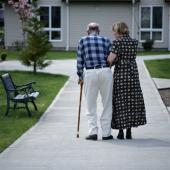
THURSDAY, Sept. 9 (HealthDay News) — Different risk factors contribute to indoor and outdoor falls among the elderly and these differences need to be incorporated into fall prevention programs, a new study suggests.
U.S. researchers studied 765 people, aged 70 and older, in the Boston area. Over two years, the participants reported 598 indoor falls and 524 outdoors falls. After someone suffered a fall, they were interviewed about the circumstances.
The study found that those who fell indoors had inactive lifestyles, more physical disabilities, took more medications, and had lower cognitive function (or thinking skills) than those who fell outdoors.
Participants who fell outdoors were generally younger than those who fell indoors, were more likely to be male and better educated, and had lifestyles that indicated better health.
The study, published online Sept. 8 in the Journal of the American Geriatrics Society, has a number of implications, said senior author Marian T. Hannan, a senior scientist at the Institute for Aging Research of Hebrew SeniorLife, an affiliate of Harvard Medical School.
The findings show that falls are not necessarily an indication of poor health and that fall prevention programs require different approaches for those at risk for indoor or outdoor falls.
“Most fall prevention programs emphasize the prevention of indoor falls, particularly through strength, balance and gait training; use of assistive devices; treatment of medical conditions; reduction in the use of certain medications; improvement in vision; and the elimination of home hazards,” Hannan and colleagues reported.
Most of these programs don’t take into account causes of outdoor falls, which make up at least half of all falls suffered by seniors each year, according to the U.S. Centers for Disease Control and Prevention. Outdoor falls tend to occur on sidewalks, streets, curbs or in parking lots, Hannan pointed out in a news release from the institute.
“Healthy, active older people should be aware of their surroundings, especially when walking outdoors. More attention needs to be paid to the elimination of outdoor environmental hazards involving sidewalks, curbs and streets, such as repairing uneven surfaces, removing debris, installing ramps at intersections and painting curbs,” Hannan recommended.
More information
The U.S. National Institute on Aging has more about older adults and falls.

